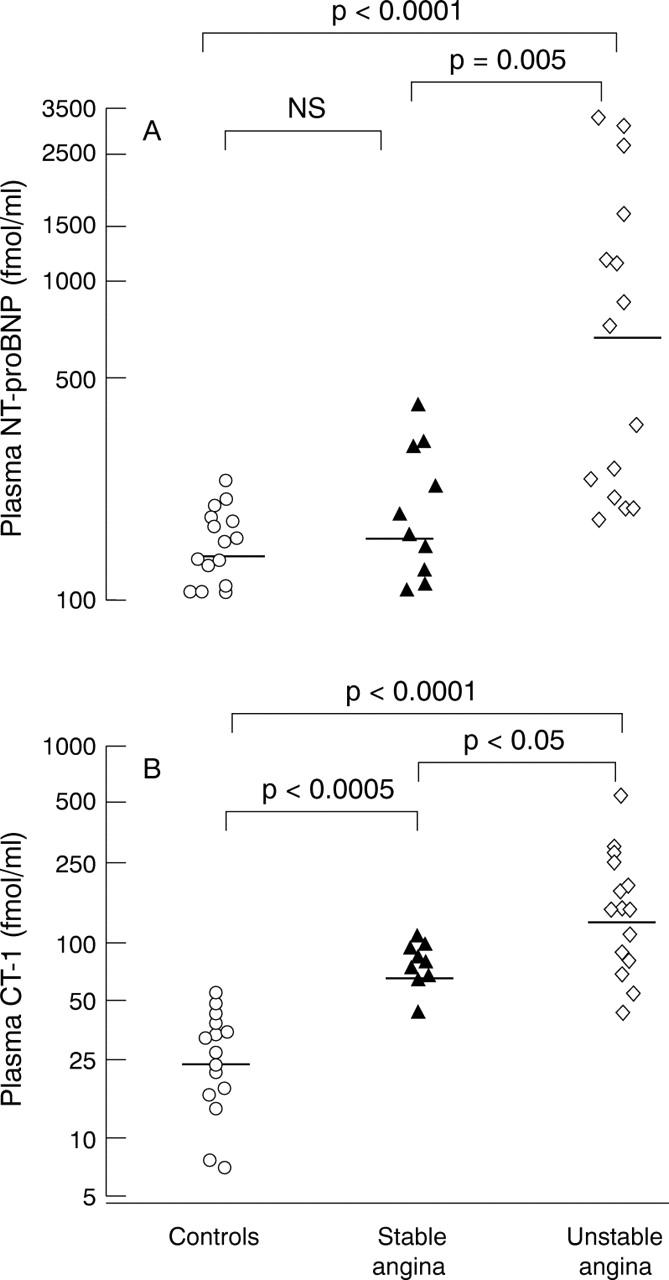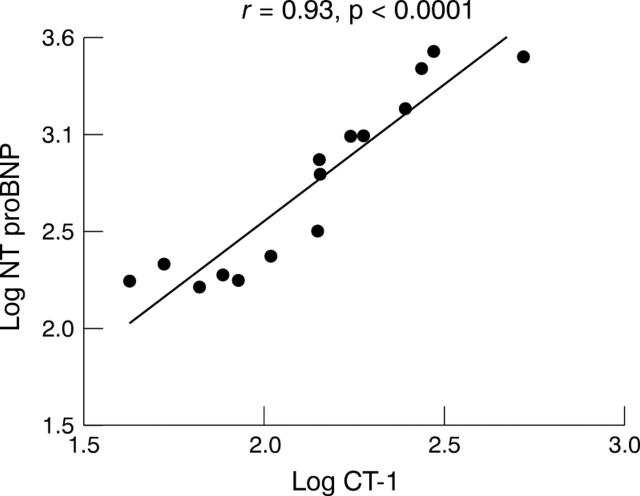Abstract
OBJECTIVE—To compare circulating concentrations of N terminal pro-brain natriuretic peptide (N-BNP) and cardiotrophin 1 in stable and unstable angina. DESIGN AND SETTING—Observational study in a teaching hospital. PATIENTS—15 patients with unstable angina, 10 patients with stable angina, and 15 controls. MAIN OUTCOME MEASURES—Resting plasma N-BNP and cardiotrophin 1 concentrations. RESULTS—N-BNP concentration (median (range)) was 714 fmol/ml (177-3217 fmol/ml) in unstable angina, 169.5 fmol/ml (105.7-399.5 fmol/ml) in stable angina (p = 0.005 v unstable angina), and 150.5 fmol/ml (104.7-236.9 fmol/ml) in controls (p < 0.0001 v unstable angina; NS v stable angina). Cardiotrophin 1 concentration was 142.5 fmol/ml (42.2-527.4 fmol/ml) in unstable angina, 73.2 fmol/ml (41.5-102.1 fmol/ml) in stable angina (p < 0.05 v unstable angina), and 27 fmol/ml (6.9-54.1 fmol/ml) in controls (p < 0.0005 v stable angina; p < 0.0001 v unstable angina). Log cardiotrophin 1 correlated with log N-BNP in unstable angina (r = 0.93, p < 0.0001). CONCLUSIONS—Both circulating N-BNP and cardiotrophin 1 are raised in unstable angina, while cardiotrophin 1 alone is raised in stable angina. The role of cardiotrophin 1 and the relation between cardiotrophin 1 and N-BNP in myocardial ischaemia remain to be defined. Keywords: cardiotrophin 1; brain natriuretic peptide; angina pectoris
Full Text
The Full Text of this article is available as a PDF (147.5 KB).
Figure 1 .

Plasma concentrations of N terminal pro-brain natriuretic peptide (N-BNP) (A) and cardiotrophin 1 (CT-1) (B) in control subjects (◯), patients with stable angina (▴), and patients with unstable angina (⋄). The uninterrupted line is the median value.
Figure 2 .
Correlation between log N terminal pro-brain natriuretic peptide (N-BNP) and log cardiotrophin 1 (CT-1) in subjects with unstable angina.
Selected References
These references are in PubMed. This may not be the complete list of references from this article.
- Biasucci L. M., Liuzzo G., Fantuzzi G., Caligiuri G., Rebuzzi A. G., Ginnetti F., Dinarello C. A., Maseri A. Increasing levels of interleukin (IL)-1Ra and IL-6 during the first 2 days of hospitalization in unstable angina are associated with increased risk of in-hospital coronary events. Circulation. 1999 Apr 27;99(16):2079–2084. doi: 10.1161/01.cir.99.16.2079. [DOI] [PubMed] [Google Scholar]
- Braunwald E. Unstable angina. A classification. Circulation. 1989 Aug;80(2):410–414. doi: 10.1161/01.cir.80.2.410. [DOI] [PubMed] [Google Scholar]
- Hughes D., Talwar S., Squire I. B., Davies J. E., Ng L. L. An immunoluminometric assay for N-terminal pro-brain natriuretic peptide: development of a test for left ventricular dysfunction. Clin Sci (Lond) 1999 Apr;96(4):373–380. [PubMed] [Google Scholar]
- Hunt P. J., Espiner E. A., Nicholls M. G., Richards A. M., Yandle T. G. Differing biological effects of equimolar atrial and brain natriuretic peptide infusions in normal man. J Clin Endocrinol Metab. 1996 Nov;81(11):3871–3876. doi: 10.1210/jcem.81.11.8923831. [DOI] [PubMed] [Google Scholar]
- Jin H., Yang R., Ko A., Pennica D., Wood W. I., Paoni N. F. Effects of cardiotrophin-1 on haemodynamics and cardiac function in conscious rats. Cytokine. 1998 Jan;10(1):19–25. doi: 10.1006/cyto.1997.0241. [DOI] [PubMed] [Google Scholar]
- Kikuta K., Yasue H., Yoshimura M., Morita E., Sumida H., Kato H., Kugiyama K., Ogawa H., Okumura K., Ogawa Y. Increased plasma levels of B-type natriuretic peptide in patients with unstable angina. Am Heart J. 1996 Jul;132(1 Pt 1):101–107. doi: 10.1016/s0002-8703(96)90396-8. [DOI] [PubMed] [Google Scholar]
- Kuwahara K., Saito Y., Ogawa Y., Tamura N., Ishikawa M., Harada M., Ogawa E., Miyamoto Y., Hamanaka I., Kamitani S. Endothelin-1 and cardiotrophin-1 induce brain natriuretic peptide gene expression by distinct transcriptional mechanisms. J Cardiovasc Pharmacol. 1998;31 (Suppl 1):S354–S356. doi: 10.1097/00005344-199800001-00099. [DOI] [PubMed] [Google Scholar]
- Nakao K., Mukoyama M., Hosoda K., Suga S., Ogawa Y., Saito Y., Shirakami G., Arai H., Jougasaki M., Imura H. Biosynthesis, secretion, and receptor selectivity of human brain natriuretic peptide. Can J Physiol Pharmacol. 1991 Oct;69(10):1500–1506. doi: 10.1139/y91-225. [DOI] [PubMed] [Google Scholar]
- Pan J., Fukuda K., Saito M., Matsuzaki J., Kodama H., Sano M., Takahashi T., Kato T., Ogawa S. Mechanical stretch activates the JAK/STAT pathway in rat cardiomyocytes. Circ Res. 1999 May 28;84(10):1127–1136. doi: 10.1161/01.res.84.10.1127. [DOI] [PubMed] [Google Scholar]
- Pennica D., King K. L., Shaw K. J., Luis E., Rullamas J., Luoh S. M., Darbonne W. C., Knutzon D. S., Yen R., Chien K. R. Expression cloning of cardiotrophin 1, a cytokine that induces cardiac myocyte hypertrophy. Proc Natl Acad Sci U S A. 1995 Feb 14;92(4):1142–1146. doi: 10.1073/pnas.92.4.1142. [DOI] [PMC free article] [PubMed] [Google Scholar]
- Richards A. M., Nicholls M. G., Yandle T. G., Frampton C., Espiner E. A., Turner J. G., Buttimore R. C., Lainchbury J. G., Elliott J. M., Ikram H. Plasma N-terminal pro-brain natriuretic peptide and adrenomedullin: new neurohormonal predictors of left ventricular function and prognosis after myocardial infarction. Circulation. 1998 May 19;97(19):1921–1929. doi: 10.1161/01.cir.97.19.1921. [DOI] [PubMed] [Google Scholar]
- Sheng Z., Knowlton K., Chen J., Hoshijima M., Brown J. H., Chien K. R. Cardiotrophin 1 (CT-1) inhibition of cardiac myocyte apoptosis via a mitogen-activated protein kinase-dependent pathway. Divergence from downstream CT-1 signals for myocardial cell hypertrophy. J Biol Chem. 1997 Feb 28;272(9):5783–5791. doi: 10.1074/jbc.272.9.5783. [DOI] [PubMed] [Google Scholar]
- Stephanou A., Brar B., Heads R., Knight R. D., Marber M. S., Pennica D., Latchman D. S. Cardiotrophin-1 induces heat shock protein accumulation in cultured cardiac cells and protects them from stressful stimuli. J Mol Cell Cardiol. 1998 Apr;30(4):849–855. doi: 10.1006/jmcc.1998.0651. [DOI] [PubMed] [Google Scholar]
- Talwar S., Downie P. F., Squire I. B., Barnett D. B., Davies J. D., Ng L. L. An immunoluminometric assay for cardiotrophin-1: a newly identified cytokine is present in normal human plasma and is increased in heart failure. Biochem Biophys Res Commun. 1999 Aug 11;261(3):567–571. doi: 10.1006/bbrc.1999.1084. [DOI] [PubMed] [Google Scholar]
- Talwar S., Squire I. B., Davies J. E., Barnett D. B., Ng L. L. Plasma N-terminal pro-brain natriuretic peptide and the ECG in the assessment of left-ventricular systolic dysfunction in a high risk population. Eur Heart J. 1999 Dec;20(23):1736–1744. doi: 10.1053/euhj.1999.1694. [DOI] [PubMed] [Google Scholar]
- Yandle T. G., Richards A. M., Gilbert A., Fisher S., Holmes S., Espiner E. A. Assay of brain natriuretic peptide (BNP) in human plasma: evidence for high molecular weight BNP as a major plasma component in heart failure. J Clin Endocrinol Metab. 1993 Apr;76(4):832–838. doi: 10.1210/jcem.76.4.8473392. [DOI] [PubMed] [Google Scholar]



